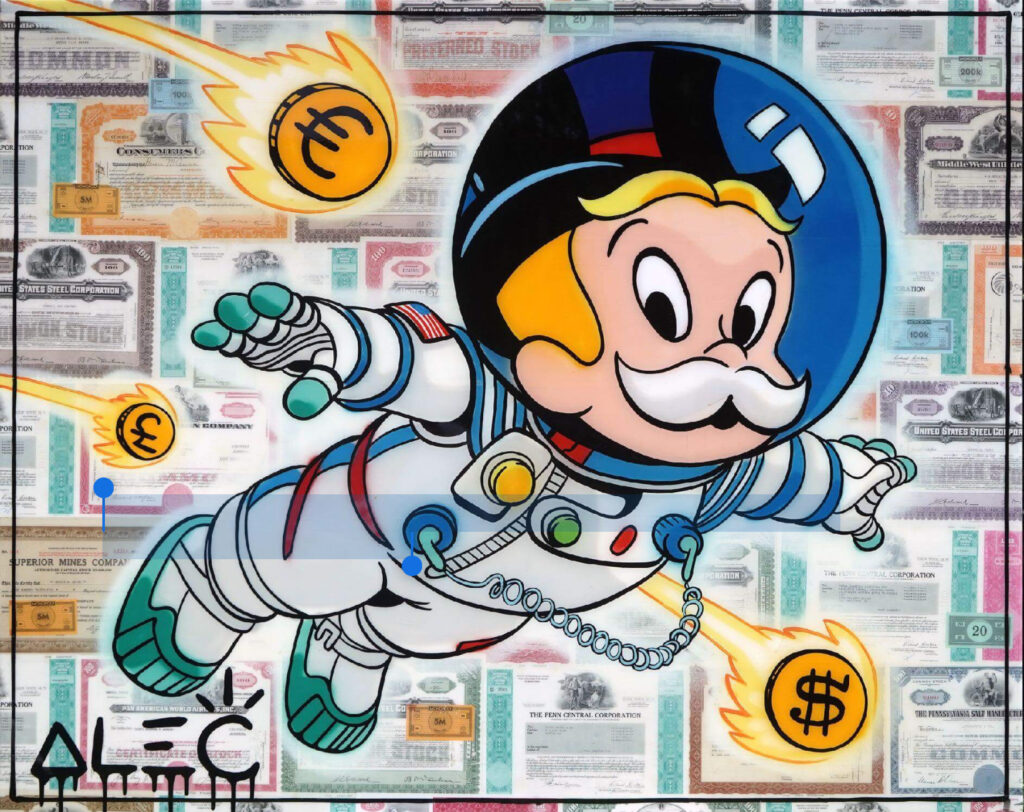Alec Monopoly, the elusive graffiti artist whose masked persona has become as iconic as his Monopoly Man motif, has long blurred the lines between capital and cartoon. His latest work, Astronaut Rags Two Richie Flying Crypto, a mixed media painting of frenetic energy and paradoxical delight, catapults his visual lexicon into the celestial and speculative—blending Wall Street, outer space, and cryptocurrency into one hyper-saturated pop economy. Here, Monopoly doesn’t just tag canvas with nostalgia or critique; he launches his emblematic Richie Rich into orbit.
It is, in every sense, a painting in motion. Not motion in the literal kinetic sense, but in its ideological propulsion. Astronaut Rags Two Richie is a rocket blast through capitalism’s past, present, and projected futures. At its center: Richie Rich, no longer just the cherubic heir of 1950s comic books, but a crypto-fueled astronaut, gliding above a technicolor debris field of gold bars, dollar signs, and pixelated symbols of Web3. Richie is airborne—defiantly gleeful, absurdly rich, and eternally unbothered.
The Space Race of Wealth
In the piece, Richie is no longer earthbound. He’s garbed in a chrome space suit—half-Futurist, half-Versace—scrawled with crypto motifs and streaked with gold-leaf applications. This isn’t the sterile NASA aesthetic of functionality. It’s maximalism in orbit. His helmet is off; his boyish face smirks toward the viewer as if to say, I’ve done it again. He floats above a planetary landscape strewn with graffiti tags, Bitcoin icons, and the remnants of shattered financial institutions—a Dow Jones dystopia reimagined as playground.
Alec Monopoly has long engaged with visual capitalist satire—turning the Monopoly Man into a Robin Hood for the streetwear era, painting Bernie Madoff in neon halos, layering currency with drips of acrylic sarcasm. But here, in this astral rendering, he doesn’t just reflect economic absurdity—he transcends it.
The astronaut suit is symbolic: a modern conqueror’s armor. The frontier isn’t land, sea, or internet anymore—it’s space and blockchain. The wealthy, the daring, and the digitally enfranchised now lift off. In Monopoly’s world, Richie Rich doesn’t age; he upgrades.
Layers of Medium, Layers of Meaning
Executed in layered mixed media—spray paint, acrylic, ink, gold foil, resin, collage—the work refuses flatness. The canvas behaves like a stock ticker, chaotically alive, always in motion. Monopoly collides the gloss of luxury with the grit of graffiti: high/low, old/new, cartoon/real.
Drips of black paint streak downward like melting asphalt or dissolving oil futures. Cutouts from financial newspapers (faux or real, it hardly matters) are lacquered into the background, alongside QR codes and crypto wallet patterns. The irony is baked in: the analog hand painting a digital dreamscape. The work exists at the precise point where traditional wealth symbols crash into their decentralized successors.
Even the color palette shouts contradiction—violent pinks and yellows explode behind silver-leaf constellations, while Richie himself glows like a marketing render, outlined in white to separate him from the chaos he commands. Around the borders, Alec Monopoly has scrawled his signature tag—half menace, half graffiti gospel.
From Wall Street to Web3: A Visual Shift
What makes Astronaut Rags Two Richie especially compelling is how it narrates a broader cultural shift. Monopoly’s work has always embodied late-stage capitalism’s greatest hits—stock tips, celebrity tycoons, dripping Benz logos. But with this piece, he hints at its next evolution.
Richie Rich, rebranded as a crypto-flying astronaut, is no longer just the son of a banker. He’s a DAO-funded, NFT-backed, metaverse citizen. The painting becomes a microcosmic map of how money moves: from paper, to plastic, to ledger lines in the sky. The painting doesn’t ask if crypto will replace traditional finance. It shows that, for the Richie Riches of the world, it already has.
Here, Monopoly poses a central question: What does wealth even mean when it’s no longer visible, no longer touchable, no longer fixed? Richie doesn’t carry coins. He floats beside blockchain icons and data clouds. It’s a new kind of richness—infinitely speculative and entirely unbothered by gravity.
Satire or Seduction?
Of course, part of Alec Monopoly’s enduring controversy lies in whether his work is critique or celebration. Astronaut Rags Two Richie doesn’t resolve that tension—it thrives in it. On the one hand, Richie’s absurd elevation—his smug expression, his detached coolness—feels like a mockery of modern plutocracy. But on the other, the sheen of the painting, its vibrancy and luxe textures, undeniably seduce.
This is Monopoly’s genius: to paint both the dream and the nightmare. The fantasy of escaping Earth with your wealth intact, and the absurdity of needing to in the first place. It’s as if the world is burning, but Richie has an escape pod—and it’s sponsored by Ethereum.
There’s a historical lineage here too: from Warhol’s soup cans to Basquiat’s crowns, from Koons’ balloon dogs to Banksy’s shredded auction pieces. Monopoly picks up that thread and applies it with street-level irreverence. He’s not looking to be subtle. He wants the image to hit you like a crypto crash or a champagne pop.
Surmise
Even amid its postmodern chaos, Astronaut Rags Two Richie leans heavily on nostalgia. Richie Rich isn’t a new icon—he’s mid-century innocence incarnate. But in Monopoly’s hands, he becomes a cipher: malleable, eternal, corrupted by time but never aged.
In an era where technology gallops ahead, and money evaporates into apps and blockchain, the use of Richie as the vehicle of critique anchors us emotionally. We know this kid. We grew up with him. And now he’s rich in new ways—ways we barely understand, ways we’re all trying to catch up with.
It’s haunting, really. Because in watching Richie Rich fly through Alec Monopoly’s cosmic crypto-collage, we realize something: he’s not just leaving Earth behind.
He’s leaving us.
No comments yet.








